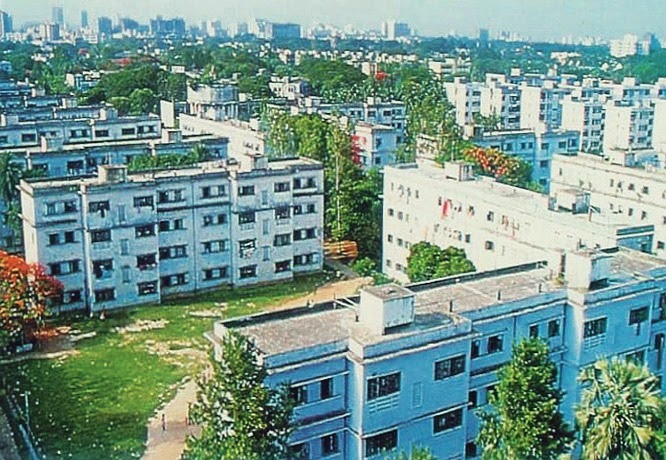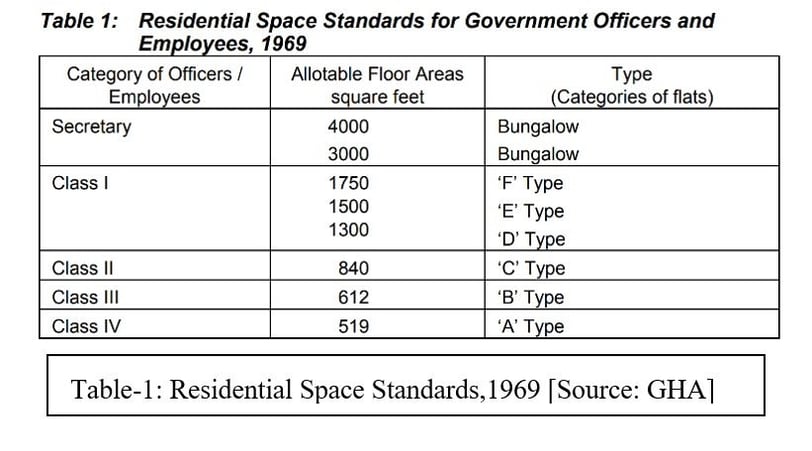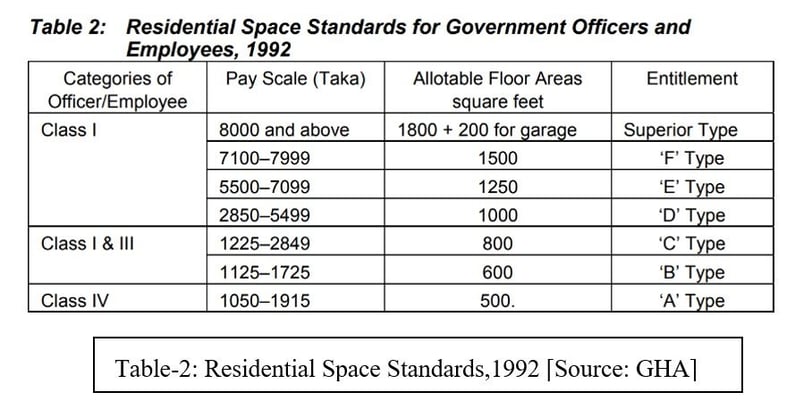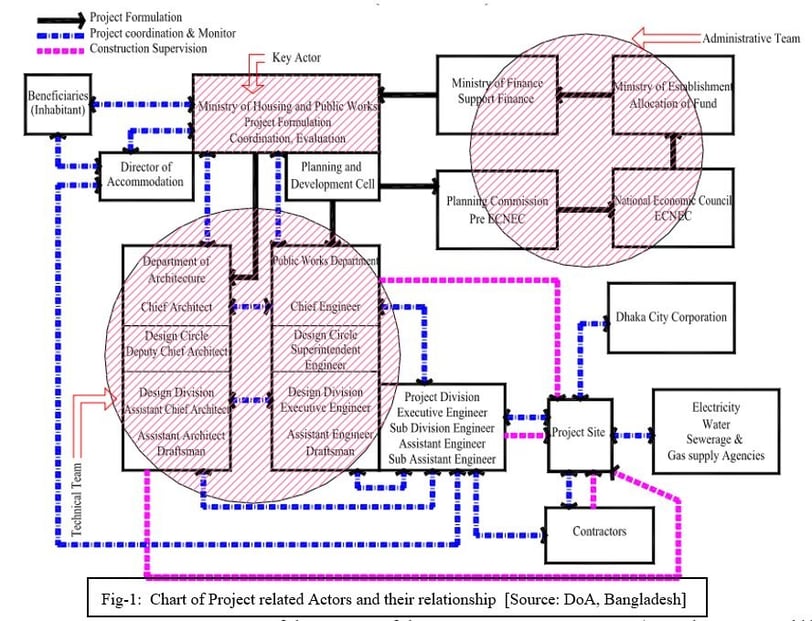Theories & Literature Review Regarding Public Housing of Bangladesh
In this blog, I have discussed in detail the theories and literature regarding the public and govt. housing in Bangladesh.
SUSTAINABLE LIVING
Muhammad Golam Sami
9/21/202213 min read


Image: Old Azimpur Govt. Housing
Literature Review: With the exception of a few sidewalk dwellers in our main cities, we all have a house or a shelter to live in, regardless of our social rank or economic situation. The quality of the structure we live in can also vary depending on a variety of internal and external factors that we react to on a very intimate and frequently negative level. As a result, housing is a topic on which everyone has an opinion. But in the question of Govt. Housing design procedure, the thought of passive and most potent stakeholders, the dwellers, is ignored. As govt. Housing design and construction executed by some govt. institutions that can not sync correctly, and due to this, some fatal residential errors have been created. This literature review will focus on past design procedures of the Azimpur govt. Housing as well the national and international design techniques regarding sustainable approach and vertical adaptation.
Core of Designing Housing: We all react to our home environment, frequently pleasantly but also frequently badly, because it lacks the fundamental needs that respect our sentimental values and inspire pride in the entire physical surroundings. Environment includes the physical surroundings, such as homes, housing projects, and neighborhoods, and their social and economic aspects (Francescato 1998).
One of the most challenging tasks in the discipline of architecture is the design of homes. The development of housing and space standards requires a thorough understanding of the nature of human requirements. A shelter meets people's practical, interpersonal, and spiritual needs.
The role of the designer is crucial when it comes to housing provision, and the success or failure of a housing development will depend in part on the aesthetic quality of the home environment, including the "good looks" of the building, the quality of the exterior space in the streets, in the landscape, and in gardens, as well as the general appearance and accessibility of the neighborhood.
As a result, the housing problem cannot be limited to creating beautiful structures for the middle and upper middle classes while ignoring apartment complexes that house the same class of individuals. The urban housing problem must be addressed from a broader socioeconomic perspective so that the majority of people have access to basic living necessities. Before we begin to build, we must first develop a "design for life" for individuals whom we desire to shelter.
Govt. Housing Policy: The National Housings Policy demonstrates the government's willingness to play a larger role in stimulating the building of affordable housing.The purpose of this study is to analyze the state of public housing in Dhaka City through an examination of Azimpur Governmental Housing. This article finishes with some broad recommendations for making better use of underutilized land in Public Housing zones.
Throughout the years, the government has made attempts to provide housing for government employees, servants, the general public, and the urban poor have yet to make a substantial difference in the urban housing picture, much alone the condition in rural regions. The recent publication of the National Housing Policy-1993, as updated in 1999, demonstrates the government's awareness about this issue and the approach for boosting housing supply through private sector investment. "The government seeks to establish a favorable and conducive atmosphere in the country in order to give momentum to this (housing) industry." The government's goal is to make housing available to all Bangladeshis through a variety of measures, incentives, motivation, planning, and administration. Special housing projects will be implemented in both the public and private sectors for low-income groups, the underprivileged, the homeless, and the shelterless."
Public Housing: The Ministry of Housing and Public Works and its various departments/directorates, including the Department of Architecture, Public Works Department (PWD), Housing & Settlement Directorate (HSD), City Development Authority namely Rajdhani Unnayn Kartripakkhya (RajUK), Urban Development Directorate (UDD), and others, carry out most housing-related activities on behalf of the government.
During the previous 40 years, the public sector has most likely contributed directly or indirectly to less than 10% of total urban housing activity. The official private sector has just emerged, although its presence is restricted to one or two major cities. Despite a limited number of sites and services projects, core housing, apartment for sale and slum upgrading, and rehabilitation plans for the general public are all available. Public housing has mostly served the demands of government employees.
During the British Empire, bungalows were erected for high-ranking officials and barracks for employees. Following India's division in 1947, there was a huge difficulty with the lodging of government employees who had relocated from India. The Pakistan Public Works Department constructed Motijheel colony in Dhaka and Agrabad Colony in Chittagong for the personnel of the Central Government's needs and public housing. The Provincial Government established Azimpur Colony and Eskaton Garden Governmental Housing in Dhaka for government officers.
There are now 11,678 residential units under the administration of the Ministry of Housing and Public Works for around 15,000 government executives and workers in Dhaka City.
Public Housing Space Standards: The Provincial Government's WPI Ministry produced a guideline on office and residential space regulations for government executives and workers in 1969. We have, according to this guidebook (table 1)




Following the independence of Bangladesh in 1971, there were broad government operations and a fast expanding number of personnel to be accommodated around the country.
In 1980, the Ministry of Public Works and Urban Development established home space guidelines for 21 levels of the National Pay Scale, divided into six residential groups (IM-25/77/80,dt 9.5.80). After many amendments, the Ministry of Works published housing entitlements in the form of a gazette notification in May 1992 (SRO no 106-Law/92 S-2/2M12/91,dt 9.5.92).
The notification (Table 2) shows that the building types and pay scale levels have changed. The method reflects the government's stance toward drastically reducing dwelling size (1800 sq ft. flats instead of Bungalows (3000- 4000 sq ft.) for higher categories of officials and offering more lodging to low-paid personnel. The Department of Architecture has created a standard set of residential building designs for various levels of government employees. These are reproduced around the country as needed to suit the housing demands of government employees.
Actors: Main Institutions and their Respective Responsibilities in the Public Housing Provision and Funding. The Ministry of Housing and Public Works and the following Departments/ Directorates under it are involved in the public housing provision.
The Department of Architecture is the sole government architectural agency in charge of planning all public housing projects and governmental structures nationwide.
The Public Works Department (PWD) is concerned with the construction and maintenance of govt offices/ institutional building and public housing for the govt servants.
Housing and settlement Directorate (HSD) is vested with the responsibility of building houses for general public especially for low and lower middle income housing in the country. HSD has been involved in the provision of serviced plots, core houses, semi-pucca houses, flats, and slum upgrading schemes.
The City Development Authority, RAJUK, is in charge of creating physical plans, acquiring property, allocating plots for development, enforcing regulations on private development and construction permits, and clearing and rehabilitating slums.
The creation of urban and regional planning policies and plans is the sole responsibility of the Urban Development Directorate (UDD). The public housing is financed by the Ministry of Finance. Consequently, funding is provided for housing construction operations.
House Building Finance Corporation (HBFC) gives mortgage lending for housing construction to the people. There are different agencies that are responsible for regulation and control over the design and construction of housing its location, necessary infrastructure, services and social facilities essential for housing areas. There are also other institutions for the distribution of housing and planning in Dhaka city.
The National Economic Council (NEC) is for policy, and programme and overall decisions. The Planning Commission is responsible for policy and programme review.
Water Supply and Sewerage Authorities are responsible for water, sewerage and drainage.
Titas Gas is responsible for gas supply.
Dhaka City Corporation (DCC) is responsible for slum redevelopment and urban utility maintenance.
Research and development on construction and materials are the responsibility of the Housing and Building Research Institute. Although there are several agencies engaged in housing-related activities, the range of their services is still rather constrained. Government employees and somewhat wealthy higher-income groups are the only beneficiaries of these mass housing organizations due to a lack of funding and an effective housing strategy.
Govt. Housing-Related Actors & Their Key Role: The Ministry of Housing and Public Works is the key actor in the Azimpur Governmental Housing Area project formulation, monitoring, and assessment. The Ministry of Housing and Public Works works with both the Administrative and Technical Teams on the proposed project. The Administrative Team is involved in project development, funding allocation, and support financing. The Ministry initiates the project and prepares the PCP (Project Concept Paper) through its Planning & Development Cell, which then sends the program to the Planning Commission for pre-ECNEC (Executive Committee of the National Economic Council) program review, after which it proceeds to the National Economic Council for ECNEC decision. The initiative is approved by the National Economic Council and forwarded to the Ministry of Establishment for funding.
The proposed project's design, supervision, coordination, monitoring, and assessment are all handled by the technical team. Through the Department of Architecture and the Public Works Department, the Ministry of Housing and Public Works oversees the proposed project's whole design, construction, supervision, and assessment process (PWD). The Chief Architect oversees the Department of Architecture, while the Deputy Chief Architect oversees a design circle.
Under a design circle, there are three design departments led by Assistant Chief Architects. Under the direction of a Deputy Chief Architect, the Assistant Chief Architect of the concern design division is tasked for designing and drawing up the master plan, site plan, and architectural designs (building plans). The Assistant Chief Architect oversees construction work to ensure that it is carried out in accordance with architectural plans and specifications. They also provide direction and instruction to site engineers, contractors, and suppliers regarding the quality of their work and the supplies they should use in accordance with the architectural drawings and specifications, and they communicate and work in coordination with the client ministry and design engineers. The PWD's current organizational structure must be used to carry out the project; the organization's chief engineer serves as the organization's chief coordinator.
Project Director who is the supervising engineer for the project circle. The primary organization responsible for project implementation is the office of the Executive Engineer for PWD's Azimpur Project Division. The Executive Engineer is tasked with serving as the project manager and creating the PP (Project Proforma) for the planned project. He or she is also in charge of supervising, organizing, and keeping track of the construction activities. Based on the architectural design provided by the Department of Architecture, the Executive Engineer of PWD's design division is tasked with creating a structural design. The relevant Electrical and Mechanical branch of PWD also creates electrical and mechanical designs and drawings.
The concerned Executive Engineer of (Azimpur site) Project Division of PWD would launch bidding for the Contractors after receiving Ministry of Housing and Public Works clearance for the implementation of the project (Civil, electrical, water supply and sanitary contractors). The PWD Project Division manages contractors, issues government checks, and oversees ongoing construction projects. The PWD also works with other organizations that are involved in the construction process to coordinate tendering, procurement, purchasing, contract signing, and payments to electricity, water, sewerage, and gas supply connections.
The project site's roads, drainage, and waste disposal system are all maintained and managed by Dhaka City Corporation. Because Public Housing does not permit any target group engagement in the overall process, residents of the Azimpur Governmental Housing have a passive role in the development process. The latest Type Design of residential flats for government employees reflects the preference of residents preferring apartments with more tiny rooms as opposed to fewer larger ones.The project site's roads, drainage, and waste disposal system are all maintained and managed by Dhaka City Corporation. Because Public Housing does not permit any target group engagement in the overall process, residents of the Azimpur Governmental Housing have a passive role in the development process. The latest Type Design of residential flats for government employees reflects the preference of residents preferring apartments with more tiny rooms as opposed to fewer larger ones.
Buildings are delivered to the Directorate of Accommodation through the secretary of the Ministry of Housing and Public Works when the projected project's construction is complete. According to the priority lists of the several Ministries, the Directorate of Accommodation distributes the apartments to the government employees. Government employees receive an additional 40 to 50 percent of their pay as a housing rent allowance. The individual who receives government housing is not eligible for this home rent allowance and also must pay the government a monthly house rent payment equal to 5 to 7.5 percent of his or her wage.
This is how the government raises money to pay for the upkeep of the public housing for its employees. The examination of government-built rental housing for government employees has shown that current public housing laws do not make an effort to have beneficiaries pay the entire cost of housing. The amount of rent that is collected is insufficient to pay for annual maintenance expenses, and it does not help to recoup the capital investment. The yearly housing provision is far below demands due to the poor use of the restricted housing budget allotment. The link between the Administrative Team, Technical Team, and Beneficiaries is depicted in the following diagram (Inhabitants).


Thoughts Regarding The Renovation: Alongside the construction of new homes, existing homes should be improved and renovated. Before a new master plan can be created for this area, the following issues may be taken into account in order to formulate clear-out policies for the successful implementation of the strategy of the current government after analyzing the various characteristics of the entire area of the Azimpur Government Housing:
Ø What would the proposed apartments' equal size be?
Ø Which poling in regards to building heights would be used?
Ø Was it for a high-rise (10/16 stories), mid-rise (5 stories), or mixed development?
Ø What steps would be taken in the restoration of the current housing stock?
Ø Would they be apartments in the same category, a higher category, or a lower category?
Despite its prime and central position, high land value, and low intensity of development (low FAR, ground covering, and density), the Azimpur Governmental Housing Area in Dhaka City generates very poor financial returns due to its low rents. It becomes difficult to attain the permitted density, ground coverage, and FAR if the mix of different dwelling types is not carefully considered in a housing design (Floor Area Ratio). The development of a new master plan, which has been waiting on decisions from the Ministry of Housing and Public Works, should fully investigate the future potential of the Azimpur Governmental Housing Areas.
The issue of government housing in Dhaka would be partially resolved if the approach is successfully implemented. The government will generate more money in the form of home rent by saving a portion of the house rent allowance. Additionally, although it is modest in the context of the metropolis of Dhaka, it will nonetheless have an impact on the strain placed on privately leased homes, which will in turn help stop the growing cost of housing. This will aid in establishing social discipline.
Future Prospects Of the Department Of Architecture:
Everyone has to be aware of the possibility that housing initiatives like those that have been so successful in other nations may not work as well here. This is due to the fact that any program's acceptance is based on how well it meets the demands of the people's socioeconomic, moral, religious, and psychological needs. As a result, it makes more sense to use the information we gain from successful foreign examples within the context of our own culture and environment rather than just replicating them. Various types of residential flat designs have been created in the last 20 years for usage in the public housing sector, where they have been employed to construct numerous government housing projects.
The Department of Architecture's architects have been instrumental in creating architecture that is appropriate for this nation given the socioeconomic circumstances of the country. The font designs were created taking into account the Bangladeshi environment, little resources, insufficient land, and technological know-how. The supply of government housing is influenced by the availability of land, money, how well those resources are used, and the method for raising money.
It is crucial that present legislation be updated in order to reduce the demand for public housing, preserve, update, and effectively use the current stock, as well as to mobilize funds for efficiency and effectiveness. The capital of Dhaka has a unique aspect thanks to government housing complexes. Therefore, it is crucial to design government housing with proper regulation compliance, good specification, and quality construction for all government housing for durability, as well as functional, affordable, and energy-efficient house designs and layouts for creating an environment conducive to good living.
Reconsider the government's function in the shifting future scenarios as a provider of government rental housing or a facilitator of its own permanent shelter for its government employees. The primary concern with public housing is the necessity for the government to define its own role in securing or promoting housing and shelter for the populace. Focus has to be placed on supplying the three primary fundamental inputs, namely land, services/infrastructure, and finance/credit, in line with the government's acknowledged role as a facilitator. This will allow households to develop their own units in accordance with their means and preferences. Making housing more accessible to lower-income populations can also encourage the private sector to take on a bigger role in providing for their housing requirements.
Public activities must be performed in the aforementioned domains to facilitate the housing supply and delivery system. Additional direct and indirect actions by the government, such as the creation of appropriate laws and the adoption and implementation of appropriate construction industry policies, might help to improve the overall situation. These could be based on appropriate building codes and the creation of quality control guidelines through the encouragement and support of building practices research, which could be well coordinated with the National Physical Planning, National Environment Policy, and National Housing Policy, all of which were modified in 1993 and 1999. All of the social players must work together to make the Global Plan of Action a reality. involvement of a diverse range of parties, including the government, local authorities, the private sector, individuals, NGOS, CBOS, and all professional
Meet The Author
Related ARTICLES
Related PROJECTS
Revising The Renovation of Azimpur Govt. Housing , Dhaka - 1205
This project aims to provide a friendly framework for the future renovation or regeneration of these housing units in Bangladesh, taking into account the climatic and social factors that compel them to analyze the past, present, and future effects of this radical change in government housing, along with providing a structured policy for establishing government prototypes that enable government housing projects to be more sustainable and eliminate adverse effects.
Image: Azimpur Govt. Housing Renovation Visual at Bird's Eye
Location: Dhaka-1205; Year: 2023






